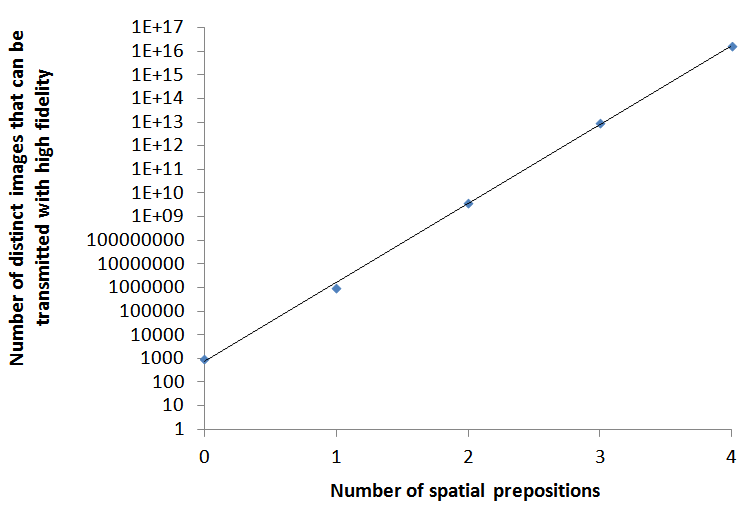
Flexible syntax, prepositions, adjectives, verb tenses, and other common elements of grammar, all facilitate the human ability to communicate an infinite number of novel images with the use of a finite number of words. The graph shows the number of distinct images that can be transmitted with high fidelity in a communication system with 1,000 nouns as a function of the number of spatial prepositions. In a communication system with no spatial prepositions and other recursive elements, 1000 nouns can communicate 1000 images to a listener. Adding just one spatial preposition allows for the formation of three-word phrases (such as: ‘a bowl behind a cup’ or ‘a cup behind a bowl’) and increases the number of distinct images that can be communicated to a listener from 1000 to one million (1000x1x1000). Adding a second spatial preposition and allowing for five-word sentences of the form object-preposition-object-preposition-object (such as: a bowl on a cup behind a plate) increases the number of distinct images that can be communicated to four billion (1000x2x1000x2x1000). The addition of a third spatial preposition increases the number of distinct images to 27 trillion (1000x3x1000x3x1000x3x1000), and so on. In general, the number of distinct images communicated by three-word sentences of the structure object-preposition-object equals the number of object-words times the number of prepositions times the number of object-words. A typical language with 1000 nouns and 100 spatial prepositions can theoretically communicate 1000101 x 100100 distinct images. This number is significantly greater than the total number of atoms in the universe. For all practical purposes, an infinite number of distinct images can be communicated by a syntactic communication system with just 1000 words and a few prepositions. Prepositions, adjectives, and verb tenses dramatically facilitate the capacity of a syntactic communication system with a finite number of words to communicate an infinite number of distinct images. Linguists refer to this property of human languages as recursion. The “infiniteness” of human language has been explicitly recognized by “Galileo, Descartes, and the 17th-century ‘philosophical grammarians’ and their successors, notably von Humboldt” (